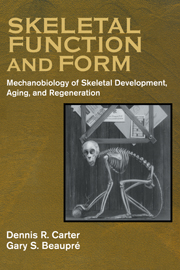Book contents
- Frontmatter
- Contents
- Preface
- Chapter 1 Form and Function
- Chapter 2 Skeletal Tissue Histomorphology and Mechanics
- Chapter 3 Cartilage Differentiation and Growth
- Chapter 4 Perichondral and Periosteal Ossification
- Chapter 5 Endochondral Growth and Ossification
- Chapter 6 Cancellous Bone
- Chapter 7 Skeletal Tissue Regeneration
- Chapter 8 Articular Cartilage Development and Destruction
- Chapter 9 Mechanobiology in Skeletal Evolution
- Chapter 10 The Physical Nature of Living Things
- Appendix A Material Characteristics
- Appendix B Structural Characteristics
- Appendix C Failure Characteristics
- Index
Chapter 1 - Form and Function
Published online by Cambridge University Press: 11 January 2010
- Frontmatter
- Contents
- Preface
- Chapter 1 Form and Function
- Chapter 2 Skeletal Tissue Histomorphology and Mechanics
- Chapter 3 Cartilage Differentiation and Growth
- Chapter 4 Perichondral and Periosteal Ossification
- Chapter 5 Endochondral Growth and Ossification
- Chapter 6 Cancellous Bone
- Chapter 7 Skeletal Tissue Regeneration
- Chapter 8 Articular Cartilage Development and Destruction
- Chapter 9 Mechanobiology in Skeletal Evolution
- Chapter 10 The Physical Nature of Living Things
- Appendix A Material Characteristics
- Appendix B Structural Characteristics
- Appendix C Failure Characteristics
- Index
Summary
Historical Foundation
The beautiful designs that can be observed in plants and animals have held a fascination for people throughout history. Intimate relationships between form and function inherent in many of these designs are perhaps nowhere as evident as in the musculoskeletal system. In the bones, cartilage, tendons, ligaments, and muscles of all vertebrates there is a gracefully efficient physical order that manifests itself on the organ, tissue, cell, and molecular levels. The existence of such a hierarchy of structural and kinematic harmony is not accidental but the result of unique and complex phylogenetic and ontogenetic histories in which genes and mechanical forces provide critical control. This book addresses the role of mechanical forces in regulating the biological processes that lead to the spatial order, size, shape, and histomorphological characteristics of the skeleton. Throughout this book we refer to this regulatory process as mechanobiology.
The fundamental questions that confront us have been faced by many investigators in the past. In the late eighteenth and early nineteenth centuries, the school of Naturphilosophie, championed by Lorenz Oken (Oken, 1809–1811), held that organic order was guided by a divine force that directed the creation of life forms with successively increasing degrees of sophistication and perfection (Gould, 1977). The final level of perfection was thought to be the human form. The Naturphilosophen deemphasized the specific mechanisms of development. The overwhelming consideration was the final organic form itself, and one could be content with the assumption that specific features exist for specific reasons. Those who ascribe to the view that all natural processes move toward a predetermined end are called teleologists or finalists.
- Type
- Chapter
- Information
- Skeletal Function and FormMechanobiology of Skeletal Development, Aging, and Regeneration, pp. 1 - 30Publisher: Cambridge University PressPrint publication year: 2000



